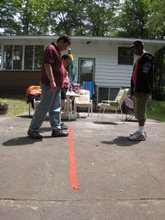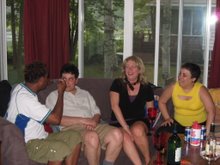 Find Balance in your Life! Invest in your HEALTH!
Find Balance in your Life! Invest in your HEALTH!Lulu Lemon Events


Social Dancing, Lessons, Practice Sessions and Special Events! Find out how to get involved!


DBC will teach basic steps of Bachatta, Merengue and Salsa


A little history about each of the dances:
BACHATA:
Bachata is a form of music and dance that originated in the countryside and rural marginal neighborhoods of Dominican Republic. Its subjects are often romantic; especially prevalent are tales of heartbreak and sadness. In fact, the original term used to name the genre was "amargue" ("bitterness," or "bitter music"), until the rather ambiguous (and mood-neutral) term bachata became popular. Bachata grew out of - and is still closely related to - the pan Latin-American romantic style called bolero. Over time, it has been influenced by merengue - a fast paced danceable music also native to the Dominican Republic - and by a variety of Latin American guitar styles.
MERENGUE:
Merengue is a type of lively, joyful music and dance that comes from the Dominican Republic. Merengue means whipped egg whites and sugar in Spanish, similar to the English word meringue. It is unclear as to why this name became the name of the music of the Dominican Republic. But, perhaps, can trace its meaning from the movement on the dance floor that could remind one of an egg beater in action. This style of music was created by Ñico Lora in the 1920s; however, it was promoted by Rafael Trujillo, the president in the 1930s, and eventually became the country’s national music and dance style.
perhaps, can trace its meaning from the movement on the dance floor that could remind one of an egg beater in action. This style of music was created by Ñico Lora in the 1920s; however, it was promoted by Rafael Trujillo, the president in the 1930s, and eventually became the country’s national music and dance style.
SALSA:
Salsa music is a diverse and predominantly Spanish Caribbean genre that is popular across Latin America. Salsa incorporates multiple styles and variations; the term can be used to describe most any form of popular Cuban derived genre, such as chachachá and mambo. Most specifically, however, salsa refers to a particular style developed in the 1960s and '70s by Cuban immigrants and Puerto Rican migrants to the New York City area, and stylistic descendants like 1980s salsa romántica. The style is now practiced throughout Latin America and abroad; in some countries it may be referred to as música tropical. salsa dancing.
BACHATA:
Bachata is a form of music and dance that originated in the countryside and rural marginal neighborhoods of Dominican Republic. Its subjects are often romantic; especially prevalent are tales of heartbreak and sadness. In fact, the original term used to name the genre was "amargue" ("bitterness," or "bitter music"), until the rather ambiguous (and mood-neutral) term bachata became popular. Bachata grew out of - and is still closely related to - the pan Latin-American romantic style called bolero. Over time, it has been influenced by merengue - a fast paced danceable music also native to the Dominican Republic - and by a variety of Latin American guitar styles.
MERENGUE:
Merengue is a type of lively, joyful music and dance that comes from the Dominican Republic. Merengue means whipped egg whites and sugar in Spanish, similar to the English word meringue. It is unclear as to why this name became the name of the music of the Dominican Republic. But,
 perhaps, can trace its meaning from the movement on the dance floor that could remind one of an egg beater in action. This style of music was created by Ñico Lora in the 1920s; however, it was promoted by Rafael Trujillo, the president in the 1930s, and eventually became the country’s national music and dance style.
perhaps, can trace its meaning from the movement on the dance floor that could remind one of an egg beater in action. This style of music was created by Ñico Lora in the 1920s; however, it was promoted by Rafael Trujillo, the president in the 1930s, and eventually became the country’s national music and dance style.SALSA:
Salsa music is a diverse and predominantly Spanish Caribbean genre that is popular across Latin America. Salsa incorporates multiple styles and variations; the term can be used to describe most any form of popular Cuban derived genre, such as chachachá and mambo. Most specifically, however, salsa refers to a particular style developed in the 1960s and '70s by Cuban immigrants and Puerto Rican migrants to the New York City area, and stylistic descendants like 1980s salsa romántica. The style is now practiced throughout Latin America and abroad; in some countries it may be referred to as música tropical. salsa dancing.

Lessons - Dancing in Action:
For examples of Artists and Musicians - see side bar























































